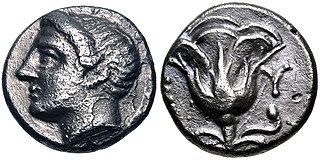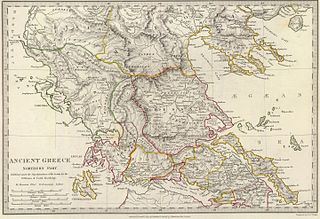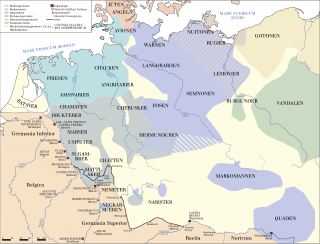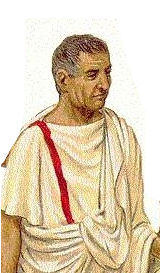
Tribune was the title of various elected officials in ancient Rome. The two most important were the tribunes of the plebs and the military tribunes. For most of Roman history, a college of ten tribunes of the plebs acted as a check on the authority of the senate and the annual magistrates, holding the power of ius intercessionis to intervene on behalf of the plebeians, and veto unfavourable legislation. There were also military tribunes, who commanded portions of the Roman army, subordinate to higher magistrates, such as the consuls and praetors, promagistrates, and their legates. Various officers within the Roman army were also known as tribunes. The title was also used for several other positions and classes in the course of Roman history.

The Battle of Potidaea was fought in 432 BC between Athens and a combined army from Corinth and Potidaea, along with their various allies. Along with the Battle of Sybota, it was one of the catalysts for the Peloponnesian War.

Memnon of Rhodes was a prominent Rhodian Greek commander in the service of the Persian Achaemenid Empire. Related to the Persian aristocracy by the marriage of his sister to the satrap Artabazus II, together with his brother Mentor he served the Persian king for most of his life, and played an important role during the invasion of Alexander the Great and the decades before that.

In the Roman army during classical antiquity, a centurion, was a commander, nominally of a century, a military unit originally consisting of 100 legionaries. The size of the century changed over time, and from the first century BC through most of the imperial era was reduced to 80 men.
A military tribune was an officer of the Roman army who ranked below the legate and above the centurion. Young men of Equestrian rank often served as military tribune as a stepping stone to the Senate. The tribunus militum should not be confused with the elected political office of tribune of the people (tribunus plebis) nor with that of tribunus militum consulari potestate.
An ala was the term used during the middle of the Roman Republic to denote a military formation composed of conscripts from the socii, Rome's Italian military allies. A normal consular army during the period consisted of two legions, composed of only Roman citizens, and two allied alae.
Acrotatus was an Agiad King of Sparta from 265 to 262 BC. He was the son of Areus I, and grandson of Acrotatus.

The primus pilus or primipilus was the senior centurion of the first cohort in a Roman legion, a formation of five double-strength centuries of 160 men; he was a career soldier and advisor to the legate. The primus pilus would remain in command for one year. They could continue to serve in the army after their term ended if there was a vacancy in command or if they wished to become an independent commander of an auxilia unit or the praefectus castrorum.
In the Roman army of the late Republic and the Principate, the tribunus laticlavius was one of the six military tribunes in a legion. Usually, it consisted of young men around age 20 who belonged to a wealthy family or were friends with the legate. The position of tribunus laticlavius was the first step on the Cursus honorum. Tribunus laticlavius are typically depicted wearing a purple cloak.

The Perrhaebi were an ancient Greek people who lived on the western slopes of Olympus, on the border between Thessaly and Macedonia. They took part in the Trojan War under Guneus and also fought in the Battle of Thermopylae.

Byzantine Empire under the Constantinian and Valentinianic dynasties was the earliest period of the Byzantine history that saw a shift in government from Rome in the West to Constantinople in the East within the Roman Empire under emperor Constantine the Great and his successors. Constantinople, formally named Nova Roma, was founded in the city of Byzantium, which is the origin of the historiographical name for the Eastern Empire, which self-identified simply as the "Roman Empire".
Princeps prior was a high-ranking Roman centurion and a member of the legion. Each of the ten cohorts that made up a legion had at its head the rank of pilus prior followed by the princeps prior. There is some controversy as to the precise order of the ranks below the pilus prior but this rank was followed by princeps prior if the order is based on seniority.

The tres militiae was a career progression of the Roman Imperial army for men of the equestrian order. It developed as an alternative to the cursus honorum of the senatorial order for enabling the social mobility of equestrians and identifying those with the aptitude for administration. The three posts, typically held over a period of two to four years, were Praefectus cohortis, Tribunus angusticlavius, and Praefectus alae.

The Battle of Histria, c. 62–61 B.C., was fought between the Bastarnae peoples of Scythia Minor and the Roman Consul Gaius Antonius Hybrida. The Bastarnae emerged victorious from the battle after successfully launching a surprise attack on the Roman troops; Hybrida escaped alongside his cavalry forces leaving behind the infantry to be massacred by the Bastarnian-Scythian attackers.

Smyrna was a port city on the Western coast of Ionia (Anatolia) that has been inhabited since antiquity, as far back as the 3rd millennium BCE. The city was once heavily fortified, and those fortifications were tested frequently during their existence and went through several iterations before the city was eventually moved to another location.

The Roman campaigns in Germania were a series of conflicts between the Germanic tribes and the Roman Empire. Tensions between the Germanic tribes and the Romans began as early as 17/16 BC with the Clades Lolliana, where the 5th Legion under Marcus Lollius was defeated by the tribes Sicambri, Usipetes, and Tencteri. Roman Emperor Augustus responded by rapidly developing military infrastructure across Gaul. His general, Nero Claudius Drusus, began building forts along the Rhine in 13 BC and launched a retaliatory campaign across the Rhine in 12 BC.

During the Roman Republic, there were watchmen that served as firefighters. They used water buckets to put out fires and axes to tear down buildings near the fire in order to prevent the fire from spreading. The aediles and tresviri nocturni were also employed to fight fires. Roman Emperor Augustus created the Vigiles. The Vigiles were an organization of freedmen that fought fires. They would use buckets and water pumps. Emperor Nero also created "bucket brigades" to help fight fires.

The Ides of March coin, also known as the Denarius of Brutus or EID MAR, is a rare version of the denarius coin issued by Marcus Junius Brutus from 43 to 42 BC. The coin was struck to celebrate the March 15, 44 BC, assassination of Julius Caesar. It features a bust of Brutus, who was one of the assassins, on the obverse while the reverse features a pileus cap between two daggers. The coin was minted in both silver and gold. Approximately 100 of the silver coins are known to exist, but only three of the gold examples have survived. The coin is considered one of the rarest ancient Roman coins.

The Vandal conquest of Roman Africa, also known as the Vandal conquest of North Africa, was the conquest of Mauretania Tingitana, Mauretania Caesariensis, and Africa Proconsolaris by the migrating Vandals and Alans. The conflict lasted 13 years with a period of four years of peace, and led to the establishment of the Vandal Kingdom in 435.














